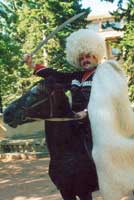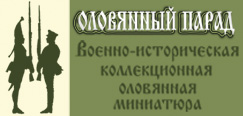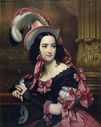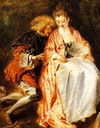Здравствуйте, гость ( Вход | Регистрация )
  |
| Voldaimar |
 19.1.2006, 17:13 19.1.2006, 17:13
Сообщение
#1
|
|
Участник   Группа: Пользователи Сообщений: 1 553 Регистрация: 1.12.2005 Пользователь №: 70 009 Репутация:  0 0  |
Базовые статьи по организации бургундской армии:
http://www.geocities.com/thorvin.geo/ordinances.htm
http://www.luc.edu/publications/medieval/vol15/15ch2.html
Надеюсь список будет пополняться. Очень мало материалов доступно в сети...
Буду благодарен за любую конкретную информацию по этому вопросу.
-------------------- переведены со старого форума Альянса
|
| Andre Grigou |
 19.1.2006, 17:36 19.1.2006, 17:36
Сообщение
#2
|
|
Участник   Группа: Пользователи Сообщений: 1 187 Регистрация: 28.11.2005 Пользователь №: 70 004 Репутация:  0 0  |
http://www.myarmoury.com/feature_armies_burg.html
-------------------- переведены со старого форума Альянса
|
| Tony |
 19.1.2006, 22:22 19.1.2006, 22:22
Сообщение
#3
|
|
Участник   Группа: Пользователи Сообщений: 1 047 Регистрация: 26.11.2005 Пользователь №: 70 002 Репутация:  0 0  |
Очень интересный сайт группы реконструкторов по Бургундии 1471-1477,
http://www.medievalproductions.nl/compagnie_de_ordonnance/regels.html
что возилось в бургундском обозе:
http://www.medievalproductions.nl/compagnie_de_ordonnance/logistics.html
в частности, очень интересный список их источников:
http://www.medievalproductions.nl/compagnie_de_ordonnance/references.html
-------------------- переведены со старого форума Альянса
|
| Def |
 10.11.2007, 23:47 10.11.2007, 23:47
Сообщение
#4
|
|
Новичок  Группа: Пользователи Сообщений: 4 Регистрация: 18.9.2007 Пользователь №: 70 641 Репутация:  0 0  |
Собственно, а самого текста ороднанса 1473 года нет? В часности интересует экпировка солдат, а то нашёл только следующее у Эмблетона:
"The equipment of most of the members of the lance is given in detail. The man-at-arms must wear a full breastplate, a fauld (a skirt of metal hoops), a sallet, barbute or armet surmounted by a plume. He must be armed with a long, light lance, a sharp knife hanging on the left side of his saddle, and a mace on the right. One of his three horses must be capable of charging and wear a plumed chamfrain and bard; and the other two, for his page and coustillier (swordsman), must have cost at least 30 ecus and 20 ecus respectively. The coustillier must wear a brigandine or a split corselet 'in the German manner', a gorget (mail or plate collar), tassets (braies d'acier, literally 'steel breeches', which could also imply mail), vambraces (armour for the forearm), and gauntlets. He must be equipped with a light lance, that may be lowered for charging if necessary -- the Burgundians interspersed their coustilliers among their men-at-arms on occasions, in order to deceive the enemy as to their real numbers, which could imply that there was not much apparent difference in equipment between them, at least from a distance. He must also have a good sword and a long double-edged dagger."
Также очень интересует информация по ордонансным ротам. Где можно почитать?
-------------------- переведены со старого форума Альянса
|
| Макс |
 13.11.2007, 11:14 13.11.2007, 11:14
Сообщение
#5
|
 Участник   Группа: Поднадзорные Сообщений: 2 070 Регистрация: 28.2.2007 Пользователь №: 85 Репутация:  38 38  |
http://books.google.com/books?id=LZcAAAAAYAAJ&printsec=titlepage&dq=Ordonnance+1473+archers&as_brr=1&ie=windows-1251&output=html
Здесь статья Гийома: H. L. G. Guillaume, Histoire de l'Organisation Militaire Sous les Ducs de Bourgogne.
P.S. Кто скачает пдф-вариант (http://books.google.com/books/pdf/Droit_institutionnel_des_communaut__s_eu.pdf?id=LZcAAAAAYAAJ&ie=windows-1251&output=pdf&sig=Fvhb5olpSgnTm4CGi9A8bcawNXY), просьба поделиться!
|
| Voldaimar |
 13.11.2007, 12:40 13.11.2007, 12:40
Сообщение
#6
|
|
Участник   Группа: Пользователи Сообщений: 1 553 Регистрация: 1.12.2005 Пользователь №: 70 009 Репутация:  0 0  |
Я скачал ПДФ. Это какая-то книга по математике. Интегралы там всякий, дифференциальные уравнения. И все это на французском.
ЖЕСТЬ! :) Может в ссылке ошибка?
-------------------- переведены со старого форума Альянса
|
| Макс |
 13.11.2007, 16:41 13.11.2007, 16:41
Сообщение
#7
|
 Участник   Группа: Поднадзорные Сообщений: 2 070 Регистрация: 28.2.2007 Пользователь №: 85 Репутация:  38 38  |
Не, просто сборник состоит из 2 разделов, с особой нумерацией страниц. Вначале идут Науки (7 статей), а потом Литература (Lettres). Статья Гийома во 2-м разделе.
|
| Макс |
 13.11.2007, 17:51 13.11.2007, 17:51
Сообщение
#8
|
 Участник   Группа: Поднадзорные Сообщений: 2 070 Регистрация: 28.2.2007 Пользователь №: 85 Репутация:  38 38  |
...
|
| Def |
 13.11.2007, 21:12 13.11.2007, 21:12
Сообщение
#9
|
|
Новичок  Группа: Пользователи Сообщений: 4 Регистрация: 18.9.2007 Пользователь №: 70 641 Репутация:  0 0  |
с 304 страницы
-------------------- переведены со старого форума Альянса
|
| Zigmund |
 14.11.2007, 16:24 14.11.2007, 16:24
Сообщение
#10
|
|
Новичок  Группа: Пользователи Сообщений: 347 Регистрация: 14.8.2006 Пользователь №: 70 193 Репутация:  0 0  |
Куркин А.В.
Бургундская армия 1465-1477 гг.
Организация, состав, вооружение, флаги, обмундирование.
http://www.fieldofbattle.ru/modules.php?name=News&file=article&sid=397
-------------------- переведены со старого форума Альянса
|
| Макс |
 15.11.2007, 12:02 15.11.2007, 12:02
Сообщение
#11
|
 Участник   Группа: Поднадзорные Сообщений: 2 070 Регистрация: 28.2.2007 Пользователь №: 85 Репутация:  38 38  |
Благодаря любезности камрада Титмара, обзавелся статьей:
Mark Ballard, "An Expedition of English Archers to Liège in 1467, and the Anglo-Burgundian Marriage Alliance," Nottingham Medieval Studies 34 (1990), 152-170
Если кого заинтересует, милости просим...
|
| Voldaimar |
 15.11.2007, 15:16 15.11.2007, 15:16
Сообщение
#12
|
|
Участник   Группа: Пользователи Сообщений: 1 553 Регистрация: 1.12.2005 Пользователь №: 70 009 Репутация:  0 0  |
Заинтересовало!
-------------------- переведены со старого форума Альянса
|
| Макс |
 15.11.2007, 15:56 15.11.2007, 15:56
Сообщение
#13
|
 Участник   Группа: Поднадзорные Сообщений: 2 070 Регистрация: 28.2.2007 Пользователь №: 85 Репутация:  38 38  |
http://books.google.com/books?id=WKINAAAAIAAJ&pg=PA358&dq=editions:0_20b0OQKN3Boanb&as_brr=1&hl=ru&ie=windows-1251&output=html
[i:baa6fa5a7f]старая биография Карла Смелого, написанная Д. Фостером Керком, раздел о военной организации.[/i:baa6fa5a7f]
http://books.google.com/books?id=n6wBAAAAQAAJ&printsec=titlepage&dq=Militaire+Bourgogne+1471&as_brr=1&hl=ru&ie=windows-1251&output=html
[i:baa6fa5a7f]депеши миланских посланников о войнах Карла Смелого[/i:baa6fa5a7f] (можно скачать в пдф)
http://books.google.com/books?id=q6Ucw8YYH2kC&pg=RA4-PA500&dq=Militaire+Bourgogne+Ordonnance+1473&as_brr=1&hl=ru&ie=windows-1251&output=html
[i:baa6fa5a7f]документы времен Карла Смелого, включая по военной тематике[/i:baa6fa5a7f]
|
| Andre Grigou |
 28.5.2008, 11:29 28.5.2008, 11:29
Сообщение
#14
|
|
Участник   Группа: Пользователи Сообщений: 1 187 Регистрация: 28.11.2005 Пользователь №: 70 004 Репутация:  0 0  |
[b:b6ac5cd843]The Abbeville Ordinance: 31 July 1471[/b:b6ac5cd843]
The Abbeville ordinance dealt with the organization of the 1,250 lances recruited in the summer of 1471.
In the Abbeville ordinance, each lance was to consist of one mounted man-at-arms, with a mounted page and a swordsman (coustillier), three mounted archers, and one crossbowman, handgonner, and pikeman on foot. This gives a total for 1,250 lances of 10,000 combatants in all (pages did not fight), divided into 12 companies. It will be noted that the distinctions between chevalier bannerets/bacheliers/écuyers has been dropped: the army is becoming a professional one, rank no longer being based on social status, and all the men at arms are paid the same. The equipment of certain members of the lance is prescribed: the man-at-arms must have full armour, three horses (two being ridden by the page and swordsmen), a war saddle and chamfron He was also issued with a vermillion velvet St. Andrew’s cross for his armour, but we are not told how it was to be fixed.
The three mounted archers must each equip themselves with 30 arrows, a bow, a two-handed sword (bastard sword most likely) and a dagger. The swordsman must have a spear, a sword and a dagger, and both he and the archers were issued with a blue and white jacket bearing a red St. Andrews cross.
As stated, the army was organized into 12 companies of 100 lances each: a company of the ordinance was commanded by a conducteur and the 100 lances were divided into tens, each group of ten commanded by a disinier. This group of ten lances was itself divided into two unequal chambres, six lances commanded by the disinier and four commanded by the chef de chambre. The chain of command stipulated that the chef de chambre was subordinate to the disinier, who must obey the conducteur. The conducteur was under the orders of the commander-in-chief. Leave of absence could be granted by the conducteur but the man-at-arms taking such leave behind in camp, or at his lodgings, his best horse, his armour, and his weapons. In each company a paymaster or auditeur was to be responsible for the troops’ pay.
Each company also enjoyed the services of a clerk and a trumpeter, and possibly a surgeon and a billeting officer. Salaries were as follows:
Conducteur
100 francs
Disinier
24 francs
Chef de Chambre
Man at Arms
15 francs
Mounted Archer
5 francs
Handgonner
4 francs
Crossbowman
4 francs
Pikeman
2 patars
Wages were distributed at inspections, which took place every quarter. However, occasions are found where salaries were paid three or even four months in arrears: this does not reflect the state of Charles’ treasury, but was common practice in order to encourage potential deserters to remain with the army until the next pay-day.
-------------------- переведены со старого форума Альянса
|
| Andre Grigou |
 28.5.2008, 11:30 28.5.2008, 11:30
Сообщение
#15
|
|
Участник   Группа: Пользователи Сообщений: 1 187 Регистрация: 28.11.2005 Пользователь №: 70 004 Репутация:  0 0  |
[b:55a2629c2f]The Ordinance of Bohain en Vermandois: 13 November 1472[/b:55a2629c2f]
Besides elaborating the previous ordinance, that of 1472 called for a slight reduction in the number of troops. There were to be 1,200 men-at-arms each accompanied by a mounted page and swordsman, 3000 mounted archers, 600 mounted crossbowmen, 2,000 pikemen, 1000 archers on foot, and 600 handgunners on foot. It may be seen that the composition of a lance was not always the same: however, the organization of the company and the hierarchy remained unchanged, as did the salaries, apart from the pikeman, who now received four francs like the handgonner and crossbowman. In this ordinance we are informed of the costume and equipment of the three infantrymen:
The handgonners should be equipped with a sleeved mail shirt, a gorgerin (presumably a mail standard or a bevor), a sallet and a breastplate. Apart from his gun, he should carry a dagger and a one-handed sword.
The archer should wear a brigandine over a padded jacket, some armoured reinforcement on his forearms, a gorgerin, a sallet, and must carry a long sharp dagger, a lead hammer (presumably for planting stakes) and a bow and a quiver hanging behind.
The pikeman must wear a sleeved jacket reinforced with plates, and a breastplate. His right arm should be protected by more plate armour, and his left arm by a targe (a small round shield). Since he would need both hands free to wield his weapon, the targe may have been fastened to his arm.
More comprehensive instructions were given for setting out on a march, an operation to be regulated by three separate soundings of the trumpets. New in this ordinance was the roll call. A list of his men was to be submitted by each man-at-arms to his disinier and by the disinier to the conducteur. One copy was to be kept by the conducteur ‘ so he can check, whenever he takes the field with his ensign, that all men-at-arms and other troops of his company are present’; the other copy was to be sent to the duke. New too were the judicial powers now given to the officers and, notably, to the conducteur. In particular, disobedience was punishable summarily, on the spot, by the officer concerned, be he conducteur or disinier. Another innovation in the 1472 ordinance was the rule that all troops enrolled in the ordinance had to swear the oath ‘to be true and loyal to my said lord (the duke) and that they would serve him against all.’
-------------------- переведены со старого форума Альянса
|
| Andre Grigou |
 28.5.2008, 11:31 28.5.2008, 11:31
Сообщение
#16
|
|
Участник   Группа: Пользователи Сообщений: 1 187 Регистрация: 28.11.2005 Пользователь №: 70 004 Репутация:  0 0  |
[b:a72e12ed0a]The Ordinance of St. Maximin de Tréves: October 1473[/b:a72e12ed0a]
This remarkable ordinance is by far the most complete, and involves a total reorganization of the companies in an Italian style. Instead of being divided into groups of ten lances, commanded by a disinier, the company is to consist of four squadrons of 25 lances, each squadron led by a chef d’escadre. The squadron is subdivided into four chambres, each of which is composed of six lances under a chef de chambre. The composition of the lance (which is not stated) was almost certainly based on the original 1471 ordinance.
In practice, the companies rarely achieved the necessary effectives, and the missing numbers were sometimes provided from the feudal levies or mercenaries not connected with the ordinances.
After the preamble, the ordinance describes how the conducteurs are to apply for their positions in writing, and their subsequent election by the duke, which is to remain in force for no more than a year. Conducteurs are responsible for selecting three of their four chefs de escadre, and hearing their oath of loyalty to the duke. The duke was to appoint the fourth chef de escadre to every company.
The chefs de chambre must furnish their superior officers with a list of names and addresses of each man under their orders. The chef d’escadre must similarly provide a list to his conducteur, who is to give one copy to the duke, if present on campaign, and keep the other in a safe place: the ordinance suggests he keep it in his hat.
Billeting procedures are set down in detail: the army must wait outside of a town while a billeting officer from each company , together with a man-at-arms from each squadron accompanied by three archers, make the necessary arrangements. Soldiers are not to leave the ranks during this time and may not take lodgings other than those allotted to them. Any complaints are to be referred to the conducteur.
For prolonged stays, however, men may choose between lodging in a hostel or in private houses, with the consent of the householder in the latter case. Much space is devoted to discipline, and the conducteurs and chefs d’escadre must assure the good conduct of their men to the population. A commissary is to be appointed to record any complaints from the civilians and make good any damage, the cost being deducted from the culprit’s next pay. The common practice of forcing one’s host to go out and buy wine at his own expense must cease forthwith, and victuals are to be paid for at market prices. However, the town is to provide cooking utensils and bedding.
The morning of departure is to be heralded by three trumpet calls. On the first, everyone must pack his baggage; on the second, the lances, chambres and squadrons must form up; and on the last call they must assemble in their respective companies. The conductor of each company must carry an ensign of distinctive design and colour (in the case of the 10th company, a violet standard bearing St. Julien at the hoist, with the ducal motto following in gold). Each chef d’escadre must carry a coronet matching his conducteurs ensign, but marked in gold lettering respectively‘c’,’cc’,’ccc’,’cccc’ for each squadron. Each chef de chambre is to wear a banderole on his sallet, again matching the company’s ensign, bearing the number of c;s corresponding to his squadron, and designating the number of his chambre. On the march everyone must keep together and carefully follow his ensign or coronet. Anyone leaving his rank to forage or pillage is to be severely punished, by loss of wages in peacetime, by loss of equipment in time of war, and if in enemy territory, by death. Deserters are of course treated most severely; and when a desertion is reported, marshals are to be sent to the offender’s place of residence to await and arrest him. The army must march for two days, progressing at least five leagues daily, and may rest on the third day only if necessary. The dukes soldiers additionally were not allowed to swear or blaspheme, nor to play with dice.
Any man requiring leave must apply in writing to the man-at-arms under whose orders he is, giving the reasons and length of time requires. If his request seems reasonable, the man-at-arms should present his case to the conducteur for his signature. The request is handed to the chef d’escadre for a further signature, then to the chef de chambre who must sign it yet again, then to the relevant man-at-arms who must also sign it, and finally back to the original applicant.
In peacetime, no more than five men-at-arms and 15 other soldiers from a squadron may take leave at any one time, and in time of war this is further restricted to two men-at-arms and six soldiers. Moreover, in order to discourage desertion, a man-at-arms must leave his best horses behind him, and a soldier all his fighting equipment. Any overstaying of leave is punished by the offender’s loss of wages for an equal time to that of his unauthorized absence.
In order to prevent squabbles, the sharing of the booty is laid down: the conducteurs are entitled to fiver percent of the value of the booty seized by their companies, the chefs d’escadre to two and a half percent of that seized by their squadrons, and the chef de chambre to a quarter of that taken by his chambre, but only if he was present when it was acquired.
Inspections of men and equipment are to be held every three months in the presence of commissaries and notaries. The borrowing or substitution of missing equipment (a regular practice even then, judging from legal records) is to be severely punished, and the offending equipment confiscated, half it’s value being paid to the accuser and half to the inspecting commissary. Pay is to be distributed at each inspection as follows:
Man-at-arms 18 francs per month
Chef d’escadre 30 pietres + 3 francs per month
Archers
Mounted crossbowmen 3 sols per day
In case of death, wages due up to time of death are to be made to the executors of the deceased.
The most remarkable section of the 1473 ordinance was that dealing with exercises and drill, which seems to have been wholly new.
“Furthermore, my lord (the duke) ordains that, in order that the said troops may be better trained and exercised in the use of arms and better practised and instructed when something happens, when they are in garrison, or have the time and leisure to do this, the captains of the squadrons and the chambres are from time to time to take some of their men-at-arms out into the fields, sometimes partly, sometimes fully armed, to practice charging with the lance, keeping in close formation while charging, (how) to charge briskly, to defend their ensigns, to withdraw on command, and to rally, each helping the other, when so ordered, and how to withstand a charge. In like manner (they are to exercise) the archer with their horses, to get them used to dismounting and drawing their bows. They must learn how to attach their horses together by their bridles and make them walk forward directly behind them, attaching the horses of the three archers by their bridles to the saddle-bow of the page to whose man-at-arms they belong:, also to march briskly forwards and to fire without breaking rank. The pikemen must be made to advance in close formation in front of the said archers, kneel at a sign from them, holding their pikes lowered to the level of a horse’s back so that the archers can fire over the pikemen as if over a wall. Thus, if the pikemen see that the enemy are breaking rank, they will be near enough to charge them in good order according to their instructions. (The archers must also learn to) place themselves back to back in double defense, or in a square or circle, always with the pikemen outside them to withstand the charge of the enemy horse and their horses with the pages enclosed in their midst. The conducteurs can begin by introducing this way of doing things to small groups and, when one of these groups is practiced and instructed, they can take out others. While doing this, the conducteurs are to keep an eye on (all) their people every day so that none will dare absence themselves or be without horses and armour, because they will not be sure on which day the conducteurs will want to take them out on exercises. Thus each will be constrained to learn to do his duty.”
The equipment of most of the members of the lance is given in detail. The man-at-arms must wear a full breastplate with a fauld, a sallet, barbute, or armet surmounted by blue and white plumes. He must be armed with a long, light lance, a sharp knife hanging on the left side of his saddle, and a mace on his right. One of his three horses must be capable of charging and wearing a plumed chamfron and bard; the other two, for his page and coustillier, must have cost at least 30 écus and 20 écus respectively. The coustillier must wear a brigandine or a split corselet ‘in the German manner’, a gorget (meaning standard or bevor), tassets, braies d’ acier (probably mail), vambraces, and gauntlets. He must be equipped with a light lance, that may be lowered for charging if necessary (coustilliers were routinely inter spaced with the men-at-arms). He must also have a good sword, and a long double-edged dagger.
The mounted archer must possess a horse worth not less than six francs, and should wear a visorless sallet, a gorget, a brigandine or a sleeveless mail shirt under a ten layer jack. He should carry a long, sharp two-handed sword and a double-edged dagger; his doublet must not have the fashionable puffed-out upper sleeves and his forearms should be armoured in such a way as to not impede his shooting. Knee length boots should be worn with short spurs and without piked toes, in order to let him walk freely. Mounted crossbowmen must wear a brigandine or corselet, light armour on the arms, a gorget, sallet, and the same spurs as the mounted archers. Their horses must not be worth less than ten écus.
Взято у коллег из-за рубежа
http://www.wolfeargent.com/ordonnances.htm
-------------------- переведены со старого форума Альянса
|
| Christian Elance |
 10.9.2008, 8:33 10.9.2008, 8:33
Сообщение
#17
|
|
Новичок  Группа: Пользователи Сообщений: 74 Регистрация: 17.12.2006 Пользователь №: 70 346 Репутация:  0 0  |
Статья о бургундской армии после смерти Карла Смелого, на французском языке. "L’armée, le Prince et ses sujets : le financement de la guerre aux Pays-Bas bourguignons après la mort de Charles Le Téméraire, 1477-1482". Найдено здесь: [url]http://www.stratisc.org/RIHM_83_20.htm[/url]
-------------------- переведены со старого форума Альянса
|
  |
2 чел. читают эту тему (гостей: 2, скрытых пользователей: 0)
Пользователей: 0
 |
|||||

|
Текстовая версия |
|
Сейчас: 24.4.2024, 16:56 | ||















